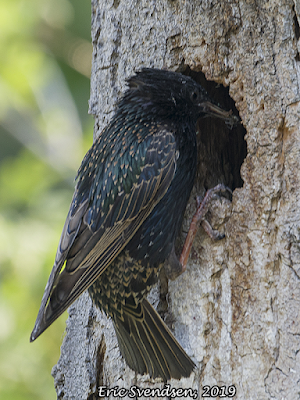The ubiquitous starling.
 |
| European Starling with a nest-hole. |
I was chatting with some young people a few weeks ago about birds, which happens to be a favourite subject of mine. I brought up the starling in the conversation, and puzzled looks fell upon their faces. "What's a starling?", they asked. To me, it was like asking what a robin was, as they are common throughout much of the world. Here, in Canada, we have loads of them; sometimes they get together in enormous flocks and fill the branches of large deciduous trees. The sound such a gathering makes can be deafening.
So, here I was, pondering to myself if this was a common occurrence (not the large collection of starlings, but rather the lack of knowledge about them in general). So, I have taken it on as a mission to inform any readers about this bird.
Starlings were originally native to Europe, including England. The playwright and poet William Shakespeare (you have heard of him, I hope) included many types of birds in his writings, among them the starling. Other mentioned species had been released into North America, but all died and none of them became established. In 1890 a man brought to New York City 60 starlings and released them all. It was supposed that they too would succumb to the elements as had their other avian friends. He would be in for a surprise.
Today there are an estimated 200 million of the birds in North America alone. They have also been introduced to Australia, New Zealand, and can be found in much of the Caribbean. They have gone as far south as central Texas but no further as they do not do well in the heat. It is amazing to think that a mere 60 birds have increased to a population of over 200 million in less than 130 years.
Their breeding success has come with numerous consequences. They are considered an invasive pest because of the harm they cause to other species. Starlings are cavity dwellers and are very aggressive; they out-compete native species such as the western bluebird for nesting sites resulting in the decline of these and other species. Further to that is their destructive habits of consuming crops and building nests and defecating in sensitive electronic areas which they can access through fairly small holes. They travel great distances in search of food and are excellent vectors in the transmission of weeds.
They cause millions of damage to crops every year. They have wiped out many bird species through competition. They cause damage to property, increase noise pollution, and leave their droppings in unwelcome places. What amazes me in all of this was the intention to help others know what a starling is for Shakespeare's sake, and today many have no idea as to what they are. There is some irony in that thought.
Thanks for reading.
Eric Svendsen www.ericspix.com



Comments
Post a Comment